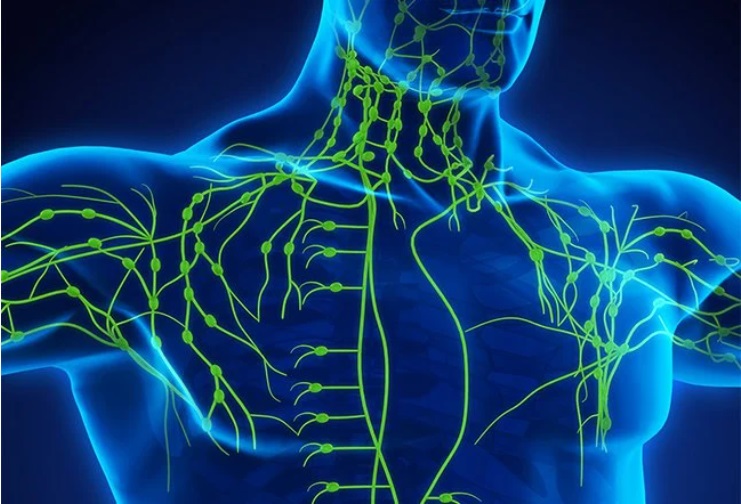Table of Contents:
- Definition-Lymph, Lymph nodes, Lymphatic system
- Parts of the lymphatic system
- Functions of lymphatic system
- Lymphatic disorders/ diseases
 |
| Lymphatic System |
The lymphatic system is a network of tissues and organs that help rid the body of toxins, waste and other unwanted materials. The primary function of the lymphatic system is to transport lymph, a fluid containing infection-fighting white blood cells, throughout the body.
Major Organs of Lymphatic System
- Lymphatic vessels
- Lymph nodes
- Thymus
- Spleen
Major Functions of Lymphatic System
- Return tissue fluid to blood
- Carry certain absorbed food molecules
- Defend the body against infection
 |
| Structure of the Lymphatic System |
Lymph
Lymph (from Latin, lympha meaning "water") is the fluid that flows through the lymphatic system, a system composed of lymph vessels (channels) and intervening lymph nodes whose function, like the venous system, is to return fluid from the tissues to the central circulation.
- Lymph is a clear, colorless, water fluid derived from tissue fluid and contained within lymph vessels.
- Lymph is similar in composition to blood except that it has a lower concentration of plasma proteins
Lymph nodes
Lymph nodes are small glands that filter lymph, the clear fluid that circulates through the lymphatic system. They become swollen in response to infection and tumors. Lymphatic fluid circulates through the lymphatic system, which is made of channels throughout your body that are similar to blood vessels.
You have about 600 lymph nodes scattered throughout your body. Some exist as a single node; others are closely connected groups called chains. A few of the more familiar locations of lymph nodes are in your armpit, groin and neck. Lymph nodes are connected to others by the lymphatic vessels.
Lymph, also called lymphatic fluid, is a collection of the extra fluid that drains from cells and tissues (that is not reabsorbed into the capillaries) plus other substances. The other substances include proteins, minerals, fats, nutrients, damaged cells, cancer cells and foreign invaders (bacteria, viruses, etc.). Lymph also transports infection-fighting white blood cells (lymphocytes).
Parts of the lymphatic system
 |
| Parts of the lymphatic system |
Composition of lymph fluid
Lymphatic vessels:
Lymphatic vessels are the network of capillaries (micro vessels) and large network of tubes located throughout the body that transport lymph away from tissues. Lymphatic vessels collect and filter lymph (at the nodes) as it continues to move toward larger vessels called collecting ducts. These vessels operate very much like your veins do: they work under very low pressure, have a series of valves in them to keep the fluid moving in one direction.
Spleen:
This largest lymphatic organ is located on your left side under your ribs and above your stomach. The spleen filters and stores blood and produces white blood cells that fight infection or disease.
 |
| Spleen |
Thymus:
This organ is located in the upper chest beneath the breast bone. It matures a specific type of white blood cell that fights off foreign organisms.
Functions of Thymus
1. Primary function-production of thymic lymphocytes.
2. A major organ for proliferation of lymphocytes in body.
3. Plays key role in determining the differentiation of T cell.
4. Lymphocytes during maturation acquire new surface antigens (The Ag) & are called as T lymphocytes or T cells (thymus dependent).
5. Lymphocyte proliferation in thymus is not dependent on antigenic stimulus (unlike in peripheral lymphoid organs).
6. T lymphocytes-primarily responsible for Cell-Mediated
7. Immunity
Tonsils and adenoid:
These lymphoid organs trap pathogens from the food you eat and air you breathe. They are your body’s first line of defense against foreign invaders.
Bone marrow:
This is the soft, spongy tissue in the center of certain bones, such as the hip bone and breastbone. White blood cells, red blood cells, and platelets are made in the bone marrow.
 |
| Bone marrow |
Peyer’s patches:
These are small masses of lymphatic tissue in the mucous membrane that lines your small intestine. These lymphoid cells monitor and destroy bacteria in the intestines.
 |
| Peyer’s patches |
Appendix:
Your appendix contains lymphoid tissue that can destroy bacteria before it breaches the intestine wall during absorption. Scientists also believe the appendix plays a role in housing “good bacteria” and repopulating our gut with good bacteria after an infection has cleared.
 |
| Appendix |
Functions of lymphatic system
It maintains the balance of fluid between the blood and tissues, known as fluid homeostasis.
It facilitates absorption of fats and fat-soluble nutrients in the digestive system.
- Lymph carries protein and large particulate matter away from the tissue space.
- End products of digestion are absorbed mainly by lymph channels.
- Important role in redistribution of fluid in the body.
- Bacteria, toxins and other foreign bodies are removed from the tissues.
- Maintenance of structural and functional integrity of tissue.
- In immune response of the body.
- Production and maturation of lymphocytes.
It forms part of the body’s immune system and helps defend against bacteria and other intruders.
Transports and removes waste products and abnormal cells from the lymph.
- Transport clean fluids back to the blood
- Drains excess fluids from tissues
- Removes debris from cells of body
- Transports fats from digestive system
- It is responsible for the removal of interstitial fluid from tissues.
- It transports white blood cells to and from the lymph nodes into the bones.
- The lymph transports antigen presenting cells, such as dendrite cells to the
lymph nodes where an immune response is stimulated. Production of immune cells (such as lymphocytes, monocytes, and antibody producing cells called plasma cells).
Lymphatic disorders/diseases:
 |
| Lymphatic disorders/diseases |






